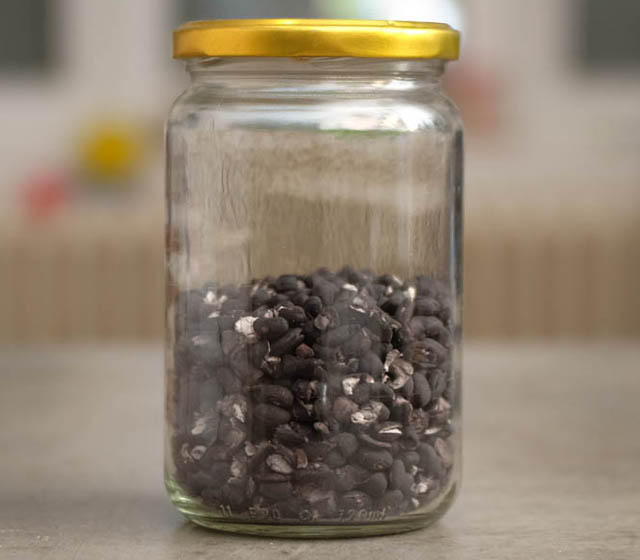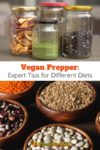In many ways, disaster prepping as a vegan or vegetarian is no different than with meat-eaters. You’ve still got to cover the essentials like safety, hygiene, and water in the same ways.
However, some aspects of prepping are unique to people on plant-based diets. Here are 9 things you need to consider as a vegan prepper.
1. Diversify Protein Sources
As far as disaster food goes, I think vegans are at an advantage. We already don’t rely on the animal-food supply chain, which can easily get disrupted.
However, vegans have a more limited selection of disaster-friendly proteins (no beef jerky, salted meat, backyard chicken eggs, or fishing, to name a few!).
Luckily, there are plenty of vegan proteins that stockpile well. Make sure to have a variety of these, so you don’t get stuck eating the same protein daily.
- Beans and lentils: Preferably multiple types of legumes, canned and dried
- Peanut butter: Note that other nut butters often have shorter shelf lives
- TVP or TSP: Stands for textured vegetable protein and textured soy protein
- Instant bean mixes: Such as falafel mix or refried bean mix
- Protein powder
- Nuts and seeds
- Whole grains
- Quinoa: Technically is a seed
- Plant-based jerky
- Tofu: Shelf-stable options include boxed silken tofu and dehydrated tofu
- Canned wheat gluten: Can often find in Asian grocers
2. Make Vegan Emergency Meals
Most emergency food brands don’t use any real meat in their meals. Instead, they use “meat substitutes” to add protein (the exceptions are more expensive brands that use freeze-dried meat). However, most emergency meals are loaded with dairy.
This can make it very hard to find pre-made vegan emergency meals. The ones that do exist are often boring and nutritionally incomplete. You are probably better off making your own meals by combining staples and freeze-dried ingredients.
Read:
3. Stockpile Egg Replacer
When the pandemic caused an egg shortage, veganism suddenly became a huge advantage. My omnivore friends called me for advice on baking and making pancakes without eggs.
I stockpile flax meal and chia as egg replacers, though other options like pre-made mixes exist. I had thought I’d had at least a year’s worth of flax meal stockpiled.
I didn’t anticipate how much extra baking I would do while hunkering down. I was blowing through my stash nearly 2x faster than expected.
The message? Stockpile more egg replacer than you think you need.
4. Get a Hand Mill
Whole grains store a lot longer than flour. However, before you stockpile grains, plan how to use them. To make flour, you’ll need a way to mill the grains.
I have a high-speed blender for milling seeds and grains into flour. It wouldn’t work during a power outage, though. I also recommend getting a hand mill in case of a long-term power outage.
5. Consider Nutrition
A typical disaster menu doesn’t provide the nutrients we need for optimal health. For vegans, B12, calcium, and iron are particularly of concern.
Here are some ways to get enough nutrients in your vegan food stockpile.
- Make a spreadsheet: I keep a spreadsheet of all the foods I have stockpiled for emergencies. The foods are broken down into groups (carbs, protein, fruit & veg, dairy alternatives, and fats). I tally how many servings of each group to ensure my stockpile is well-balanced. You can purchase our inventory planner and spreadsheets here.
- Stockpile supplements: Your nutrients should primarily come from food, but supplements are a good backup.
- Dehydrated greens powder: It’s hard to eat enough greens to meet iron and calcium requirements. I dehydrate leafy greens and then mill them into a powder. This powder can be added to bread dough, cooked grains, pancakes, soups, etc.
- Molasses: Molasses has an infinite shelf life and is an excellent source of nutrients. I eat it with peanut butter.
- Nutritional yeast: This is almost always fortified with B vitamins and can be used to make yummy vegan cheese sauces.
*Note: omnivores also need to worry about nutrition when prepping! Stockpile multivitamin and mineral supplements.

6. Grow Fresh Produce
Recently, the biggest food complaints I heard were about missing fresh greens when switching to a dried-food stockpile. People also missed other fresh produce like tomatoes, peppers, and fruit.
Your disaster food will be taken up several notches if you can grow some fresh produce yourself. Even if you don’t have a yard, you can still grow a significant amount of food in buckets on your apartment balcony or planters in your windows.
Read: How to Make a 5-Gallon Bucket Garden
7. Be Smart about Stockpiling Dry Beans
Dry beans are one of the best disaster foods for veg and non-veg people: they are cheap, have long shelf lives, and are nutritious. The problem comes with using dry beans, especially during power outages.
It takes a lot of fuel to cook a pot of beans. I usually cook beans in massive batches, bag them in individual-sized portions, and freeze them. I wouldn’t be able to do this during a power outage. I’d waste vast amounts of fuel to cook beans every day.
If stockpiling beans:
- Stockpile extra fuel: Besides stockpiling fuel for boiling water and general cooking, make sure there is enough to cook beans. Propane stoves are a good choice for power outages.
- Consider an outdoor stove: If you have a yard and wood to use as fuel, it might make sense to slow-cook beans over a fire instead of using gas indoors. You’ll need a stove, such as these rocket stove designs.
- Choose some fast-cooking legumes: Red and brown lentils cook much faster than most beans, so it’s wise to include these in your stockpile.
- Dehydrate beans: You can dehydrate cooked beans. These can then be softened by pouring water over them and letting them sit for 5-15 minutes (the process is called cold-soaking). You can also blend dehydrated beans into a flour to add to baked goods.
- Learn to sprout beans: Instead of cooking dry beans, you can sprout them. This will give you some fresh food and doesn’t require any fuel.
- Sneak beans into all meals: Once you’ve made a big pot of beans, you can use them in various ways. I even put bean mash into my bread dough, so my kids get a bit of extra nutrition!

8. Stockpile Some “Luxury” Foods
Most people prep for a “SHTF” or “doomsday” event, so they stockpile the absolute basics. But, in reality, most disasters don’t bring about doomsday: They are short-term events that are usually more inconvenient than deadly.
You’ll appreciate having some luxury vegan foods for these mild, short-term disasters. My absolute favorite is canned dolmas, which are Mediterranean stuffed vine leaves. My family was also ecstatic to have olive spread in our stockpile to eat while hunkering down through the pandemic.
Some vegan luxury prepping foods to include are:
- Cashews (and other “fancy” nuts)
- Dips and spreads
- Mayo, red pepper spread, and other condiments
- Vegan cheese powder
- Dark chocolate – read how to store chocolate long term
- Syrups
- Coffee
- Cookies and candies
- Herbs and spices (though I’ll argue these are a necessity and not a luxury!)
Vegan Prepping List
For a complete disaster-prepping list, see my book. Here, I’ve included items that vegans specifically might want to stockpile (though omnivores would also benefit from having these items):
Food:
- Fortified plant milk powder
- Fruits and veggies: Dehydrated, freeze-dried, and canned
- Whole grains and flours: Get a wide variety such as oats, kamut, quinoa, and buckwheat (Read: How to store quinoa)
- Proteins: Get a wide variety such as beans, lentils, TVP, peanut butter, and silken tofu
- Egg replacers: Such as flax meal, chia, or egg replacer mix
- Alternative sweeteners: such as maple syrup and agave syrup
- Dark chocolate
- Nutritional yeast
- Supplements
- Instant meals
- Vegan mac n’ cheese
- Canned soups, stews, and meals
- Hummus mix
- Refried bean mix
- Ramen and noodle bowls
Supplies:
- Mill, electric, and/or hand-operated
- Seeds for growing your own food
- Gardening supplies
- Non-leather sturdy boots
- Non-leather work gloves
- Dehydrator
- Canning supplies
- Book of wild edible plants in your area
Final Words…
When I tell someone I’m vegan, I often get the annoying comment, “But what if you were starving? Would you eat meat then?”
I could forage plants for food if I had to flee into the wilderness. And, if I were going to be surviving for a long time, I’d likely make some insect traps and roast crickets for food (yes, I know insects aren’t vegan!).
While it doesn’t fit into the macho fantasy of hunting and snaring game for food, plants and insects are some of the best and readily available wilderness foods you can eat.
Remember: Prepping is all about giving ourselves choices. If you prepare well, you won’t have to put yourself in a situation where you don’t have plant foods to eat.



Is There a 9th Item please? I didn’t see it in the article. Thanks, Linda
My Gratitude for your time, thoughtfulness & efforts to collect this list. I have been vegan-no-Ovum for 21 years & never compiled a pantry list. Your efforts are a blessing.
What are options for storing water longer than 4 weeks please?
Thank you. Peace to all of us. Linda
Thank you so much for this. My family is transitioning and want to get setup properly.
I think I missed the 9th item
I love this. We need to leave the macho, mighty knife, prep behind. I can not find a UK based YouTube channel for non macho vegans.
This is so helpful! I really love your positive tone and as is typical of a vegan diet, it was rich in diversity and nutrition!